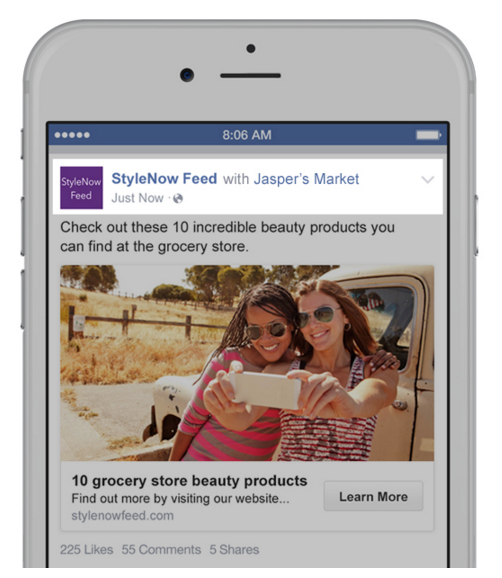Save 50% on a 3-month Digiday+ membership. Ends Dec 12.

Facebook has officially updated its policy and will now allow publishers to post ads in the form of branded content to their pages. Media outlets have been hoping for such a development to help drive more money from their efforts on the social network. The new rules allow verified pages, from publishers like NowThis and PopSugar, to post advertorial content they create with brands for their own properties.
The rules apply to its new live video product and Instant Articles, the fast-loading multimedia posts that Facebook hosts, and all other post formats.
Facebook was slow to allow branded content on publisher pages. Publishers had been pushing for more leniency in distributing such content to their massive audiences on Facebook, because while the social network demands ever higher-quality content from them, it offers few revenue opportunities.
“Is it the answer to Facebook monetization? It’s certainly part of the answer, as long as publishers stay within the rules, they can get creative with how they create value for brands,” said one publisher speaking on condition of anonymity. “And it allows, in theory, for us to monetize every video we publish and keep 100 percent of the revenue.”
Publishers have gotten away with posting branded content in the past with articles, images and videos, but doing so was technically a violation of Facebook’s rules, until now. The new system puts better labeling in place and offers more transparency.
“Along with changes to our Pages terms and ads policy, we’re offering a new tool that makes it easy for publishers and influencers to tag a marketer when they publish branded content. Publishers and influencers must use this tag for all branded content shared on Facebook,” Clare Rubin, Facebook product manager, wrote in a blog post today.

Facebook developed the tagging system for the publishers to include in ad posts, and it will let advertisers access data to see how well the posts perform. It is up to the publisher to make clear that a post is in fact sponsored to comply with disclosure rules wherever they apply, Facebook said.
For instance, during the Super Bowl, Fox Sports posted videos that were sponsored by GoDaddy. The videos had a little GoDaddy sticker, and the words “presented by” were included in the posts.
Facebook’s new guidelines control exactly how branded content can appear: “Our branded content guidelines prohibit overly promotional features, such as persistent watermarks and pre-roll advertisements. Additionally, cover photos and profile pictures must not feature third-party products, brands or sponsors,” Rubin’s blog post said. “Branded content integrations that are allowed to be posted on Facebook include content like product placement, end cards and marketer’s logos.”
Facebook has a 20-percent rule on the amount of ad copy that is allowed to appear in a given image, which limits the ability for, say, a card with a brand’s logo plastered on it to introduce a video, according to sources familiar with Facebook’s rules.
Publishers will take what they can get though when it comes to revenue opportunities on Facebook. Many have built big audiences there, but there have been few advertising answers.
Facebook encouraged video production but never had an easy ad product like YouTube’s or even Twitter’s pre-roll ads. It pushed Instant Articles, fast-loading posts hosted on the social network itself, but ad opportunities have so far proved difficult.
Facebook has a “suggested videos” product that lets users scroll through feeds of videos from a publishers and periodically throws a sponsored video in the mix, and splits the revenue.
“As new platforms come along, and particularly a platform that doesn’t have pre-roll, the whole industry has to figure out how monetization works,” said David Grant, president of PopSugar Studio, a prolific Facebook publisher. “So you have to make a system that works really well, that’s not driven by pre-roll, because that’s a better user experience, and you have to make sure it’s transparent.”
More in Media

Meta enters AI licensing fray, striking deals with People Inc., USA Today Co. and more
The platform has secured seven multi-year deals with publishers including CNN, Fox News, People Inc., USA Today Co to incorporate their content into its large language model (LLM) Llama.

European publishers say the Digital Omnibus ‘cookie fix’ leaves them worse off
The European Union’s attempt at a legislative spring clean for Europe’s web of data privacy rules, has landed flat with publishers.

Digiday+ Research Subscription Index 2025: Subscription strategies from Bloomberg, The New York Times, Vox and others
Digiday’s third annual Subscription Index examines and measures publishers’ subscription strategies to identify common approaches and key tactics among Bloomberg, The New York Times, Vox and others.





